Research on the Structure of Disciplinary Knowledge Systems from the Perspective of a Knowledge Behavior Strategy
Abstract
1. Introduction
2. Literature Review
3. Theoretical Framework
3.1. Basic Knowledge System
3.2. Knowledge Network System
4. Method
4.1. Data
4.2. Data Processing
4.2.1. Data Processing of References
4.2.2. Data Processing of Co-Authorship
4.3. Social Network Analysis
5. Results
5.1. Basic Knowledge System of Energy Chemical Engineering
5.2. Knowledge Network System of Energy Chemical Engineering
5.3. Intrinsic Connection of Disciplinary Knowledge Systems
6. Discussion
6.1. Theoretical Contributions
6.2. Policy Suggestion
6.3. Limitations and Prospects
7. Conclusions
Author Contributions
Funding
Data Availability Statement
Acknowledgments
Conflicts of Interest
Appendix A
| Disciplines | Frequency | Proportion (%) | Disciplines | Frequency | Proportion (%) |
| chemistry | 38,333 | 61.0418 | genetics and heredity | 8 | 0.0127 |
| materials science | 26,955 | 42.9233 | dermatology | 7 | 0.0111 |
| science and technology—other topics | 20,627 | 32.8466 | physiology | 7 | 0.0111 |
| energy and fuels | 16,802 | 26.7556 | research and experimental medicine | 7 | 0.0111 |
| physics | 16,108 | 25.6505 | biodiversity and conservation | 6 | 0.0096 |
| engineering | 9708 | 15.4591 | oceanography | 6 | 0.0096 |
| environmental sciences and ecology | 5348 | 8.5162 | oncology | 6 | 0.0096 |
| electrochemistry | 5135 | 8.1770 | neurosciences and neurology | 5 | 0.0080 |
| thermodynamics | 1288 | 2.0510 | psychology | 5 | 0.0080 |
| polymer science | 970 | 1.5446 | substance abuse | 5 | 0.0080 |
| biotechnology and applied microbiology | 769 | 1.2246 | astronomy and astrophysics | 4 | 0.0064 |
| optics | 550 | 0.8758 | government and law | 4 | 0.0064 |
| biochemistry and molecular biology | 389 | 0.6194 | imaging science and photographic technology | 4 | 0.0064 |
| metallurgy and metallurgical engineering | 333 | 0.5303 | pediatrics | 4 | 0.0064 |
| agriculture | 311 | 0.4952 | robotics | 4 | 0.0064 |
| mathematics | 276 | 0.4395 | veterinary sciences | 4 | 0.0064 |
| mechanics | 222 | 0.3535 | endocrinology and metabolism | 3 | 0.0048 |
| water resources | 222 | 0.3535 | fisheries | 3 | 0.0048 |
| meteorology and atmospheric sciences | 198 | 0.3153 | general and internal medicine | 3 | 0.0048 |
| instruments and instrumentation | 196 | 0.3121 | immunology | 3 | 0.0048 |
| crystallography | 152 | 0.2420 | infectious diseases | 3 | 0.0048 |
| microbiology | 146 | 0.2325 | international relations | 3 | 0.0048 |
| biophysics | 130 | 0.2070 | ophthalmology | 3 | 0.0048 |
| computer science | 117 | 0.1863 | radiology, nuclear medicine and medical imaging | 3 | 0.0048 |
| business and economics | 114 | 0.1815 | social sciences—other topics | 3 | 0.0048 |
| geology | 75 | 0.1194 | behavioral sciences | 2 | 0.0032 |
| nuclear science and technology | 68 | 0.1083 | mathematical methods in social sciences | 2 | 0.0032 |
| plant sciences | 62 | 0.0987 | physical geography | 2 | 0.0032 |
| transportation | 55 | 0.0876 | surgery | 2 | 0.0032 |
| geochemistry and geophysics | 52 | 0.0828 | zoology | 2 | 0.0032 |
| spectroscopy | 47 | 0.0748 | anatomy and morphology | 1 | 0.0016 |
| construction and building technology | 40 | 0.0637 | anthropology | 1 | 0.0016 |
| cell biology | 34 | 0.0541 | archeology | 1 | 0.0016 |
| life sciences and biomedicine—other topics | 33 | 0.0525 | art | 1 | 0.0016 |
| toxicology | 32 | 0.0510 | arts and humanities—other topics | 1 | 0.0016 |
| pharmacology and pharmacy | 31 | 0.0494 | cardiovascular system and cardiology | 1 | 0.0016 |
| food science and technology | 30 | 0.0478 | cultural studies | 1 | 0.0016 |
| telecommunications | 30 | 0.0478 | development studies | 1 | 0.0016 |
| automation and control systems | 28 | 0.0446 | entomology | 1 | 0.0016 |
| microscopy | 27 | 0.0430 | evolutionary biology | 1 | 0.0016 |
| mineralogy | 27 | 0.0430 | hematology | 1 | 0.0016 |
| public, environmental and occupational health | 21 | 0.0334 | history and philosophy of science | 1 | 0.0016 |
| marine and freshwater biology | 18 | 0.0287 | information science and library science | 1 | 0.0016 |
| mining and mineral processing | 18 | 0.0287 | integrative and complementary medicine | 1 | 0.0016 |
| acoustics | 17 | 0.0271 | medical informatics | 1 | 0.0016 |
| public administration | 14 | 0.0223 | mycology | 1 | 0.0016 |
| geography | 13 | 0.0207 | orthopedics | 1 | 0.0016 |
| operations research and management science | 10 | 0.0159 | philosophy | 1 | 0.0016 |
| education and educational research | 9 | 0.0143 | remote sensing | 1 | 0.0016 |
| forestry | 9 | 0.0143 | sport sciences | 1 | 0.0016 |
| mathematical and computational biology | 9 | 0.0143 | virology | 1 | 0.0016 |
| nutrition and dietetics | 9 | 0.0143 |
Appendix B
| Disciplines | Degree | NrmDegree | Disciplines | Degree | NrmDegree |
| material science and engineering | 1520 | 9.325 | mining engineering | 32 | 0.196 |
| chemistry | 1501 | 9.209 | control science and engineering | 29 | 0.178 |
| physics | 1415 | 8.681 | public administration | 29 | 0.178 |
| chemical engineering and technology | 1208 | 7.411 | architecture | 28 | 0.172 |
| environmental science and engineering | 575 | 3.528 | atmospheric science | 28 | 0.172 |
| electronic science and technology | 471 | 2.89 | agricultural resources and environment | 17 | 0.104 |
| mechanical engineering | 448 | 2.748 | pharmacy | 14 | 0.086 |
| biology | 411 | 2.521 | agricultural engineering | 12 | 0.074 |
| biological engineering | 393 | 2.411 | instrument science and technology | 10 | 0.061 |
| optical engineering | 219 | 1.344 | management science and engineering | 10 | 0.061 |
| power engineering and engineering thermophysics | 186 | 1.141 | transportation engineering | 10 | 0.061 |
| information and communication engineering | 130 | 0.798 | basic medical sciences | 8 | 0.049 |
| electrical engineering | 111 | 0.681 | ecology | 8 | 0.049 |
| aerospace science and technology | 110 | 0.675 | art studies | 9 | 0.055 |
| civil engineering | 96 | 0.589 | safety science and engineering | 7 | 0.043 |
| education | 76 | 0.466 | clinical medicine | 6 | 0.037 |
| mathematics | 70 | 0.429 | design studies | 6 | 0.037 |
| computer science and technology | 69 | 0.423 | food science and engineering | 6 | 0.037 |
| geology | 67 | 0.411 | food science and technology | 4 | 0.025 |
| biomedical engineering | 64 | 0.393 | marine science | 4 | 0.025 |
| plant pathology | 61 | 0.374 | sociology | 4 | 0.025 |
| metallurgical engineering | 55 | 0.337 | astronomy | 2 | 0.012 |
| petroleum and natural gas engineering | 46 | 0.282 | crop science | 2 | 0.012 |
| geography | 45 | 0.276 | safety engineering | 2 | 0.012 |
| nuclear science and technology | 44 | 0.270 | applied economics | 1 | 0.006 |
| mechanics | 43 | 0.264 |
References
- Wang, H.; Deng, S.; Su, X. A Study on Construction and Analysis of Discipline Knowledge Structure of Chinese LIS Based on CSSCI. Scientometrics 2016, 109, 1725–1759. [Google Scholar] [CrossRef]
- Carayannis, E.G.; Grigoroudis, E.; Campbell, D.F.J.; Meissner, D.; Stamati, D. The Ecosystem as Helix: An Exploratory Theory-Building Study of Regional Co-Opetitive Entrepreneurial Ecosystems as Quadruple/Quintuple Helix Innovation Models. R D Manag. 2018, 48, 148–162. [Google Scholar] [CrossRef]
- Cottafava, D.; Ascione, G.S.; Corazza, L.; Dhir, A. Sustainable Development Goals Research in Higher Education Institutions: An Interdisciplinarity Assessment through an Entropy-Based Indicator. J. Bus. Res. 2022, 151, 138–155. [Google Scholar] [CrossRef]
- Tight, M. Higher Education: Discipline or Field of Study? Tert. Educ. Manag. 2020, 26, 415–428. [Google Scholar] [CrossRef]
- Buckle, R.A.; Creedy, J. Methods to Evaluate Institutional Responses to Performance-Based Research Funding Systems. Aust. Econ. Pap. 2022, 61, 615–634. [Google Scholar] [CrossRef]
- Zhang, C.; Wang, F.; Huang, Y.; Chang, L. Interdisciplinarity of Information Science: An Evolutionary Perspective of Theory Application. J. Doc. 2023, 80, 392–426. [Google Scholar] [CrossRef]
- Xiao, L.; Chen, G.; Sun, J.; Han, S.; Zhang, C. Exploring the Topic Hierarchy of Digital Library Research in China Using Keyword Networks: A K-Core Decomposition Approach. Scientometrics 2016, 108, 1085–1101. [Google Scholar] [CrossRef]
- Fauchart, E.; Bacache-Beauvallet, M.; Bourreau, M.; Moreau, F. Do-It-Yourself or Do-It-Together: How Digital Technologies Affect Creating Alone or with Others? Technovation 2022, 112, 102412. [Google Scholar] [CrossRef]
- Zasa, F.P.; Verganti, R.; Bellis, P. Innovator or Collaborator? A Cognitive Network Perspective to Vision Formation. Eur. J. Innov. Manag. 2022, 25, 567–588. [Google Scholar] [CrossRef]
- Wang, S.; Mao, J.; Lu, K.; Cao, Y.; Li, G. Understanding Interdisciplinary Knowledge Integration through Citance Analysis: A Case Study on eHealth. J. Informetr. 2021, 15, 101214. [Google Scholar] [CrossRef]
- Kuhn, T.S. The Structure of Scientific Revolutions; The University of Chicago Press: Chicago, IL, USA, 1962. [Google Scholar]
- Veretennik, E.; Shakina, E. Beyond Borders: Achieving Research Performance Breakthrough with Academic Collaborations. High. Educ. Q. 2023, 78, 212–235. [Google Scholar] [CrossRef]
- Castañer, X.; Oliveira, N. Collaboration, Coordination, and Cooperation among Organizations: Establishing the Distinctive Meanings of These Terms through a Systematic Literature Review. J. Manag. 2020, 46, 965–1001. [Google Scholar] [CrossRef]
- Ba, Z.; Cao, Y.; Mao, J.; Li, G. A Hierarchical Approach to Analyzing Knowledge Integration between Two Fields—A Case Study on Medical Informatics and Computer Science. Scientometrics 2019, 119, 1455–1486. [Google Scholar] [CrossRef]
- Cheng, Q.; Wang, J.; Lu, W.; Huang, Y.; Bu, Y. Keyword-Citation-Keyword Network: A New Perspective of Discipline Knowledge Structure Analysis. Scientometrics 2020, 124, 1923–1943. [Google Scholar] [CrossRef]
- Sluyter, A.; Augustine, A.D.; Bitton, M.C.; Sullivan, T.J.; Wang, F. The Recent Intellectual Structure of Geography. Geogr. Rev. 2006, 96, 594–608. [Google Scholar] [CrossRef][Green Version]
- Li, R. The Cultivation of Subject Core Competencies from the Perspective of Knowledge Structure. Res. Educ. Dev. 2018, 38, 43–49. [Google Scholar] [CrossRef]
- Li, R. The Selection and Analysis of Subject Core Competencies in the Perspective of Knowledge Structure. Nanjing J. Soc. Sci. 2019, 4, 138–144+156. [Google Scholar] [CrossRef]
- Deng, S.; Xia, S. Mapping the Interdisciplinarity in Information Behavior Research: A Quantitative Study Using Diversity Measure and Co-Occurrence Analysis. Scientometrics 2020, 124, 489–513. [Google Scholar] [CrossRef]
- Daenekindt, S.; Huisman, J. Mapping the Scattered Field of Research on Higher Education. A Correlated Topic Model of 17,000 Articles, 1991–2018. High. Educ. 2020, 80, 571–587. [Google Scholar] [CrossRef]
- Lyu, H.; Bu, Y.; Zhao, Z.; Zhang, J.; Li, J. Citation Bias in Measuring Knowledge Flow: Evidence from the Web of Science at the Discipline Level. J. Informetr. 2022, 16, 101338. [Google Scholar] [CrossRef]
- Mora, L.; Deakin, M.; Reid, A. Combining Co-Citation Clustering and Text-Based Analysis to Reveal the Main Development Paths of Smart Cities. Technol. Forecast. Soc. Chang. 2019, 142, 56–69. [Google Scholar] [CrossRef]
- Hou, J.; Yang, X.; Chen, C. Emerging Trends and New Developments in Information Science: A Document Co-Citation Analysis (2009–2016). Scientometrics 2018, 115, 869–892. [Google Scholar] [CrossRef]
- Bornmann, L.; Haunschild, R.; Hug, S.E. Visualizing the Context of Citations Referencing Papers Published by Eugene Garfield: A New Type of Keyword Co-Occurrence Analysis. Scientometrics 2018, 114, 427–437. [Google Scholar] [CrossRef] [PubMed]
- Khasseh, A.A.; Soheili, F.; Moghaddam, H.S.; Chelak, A.M. Intellectual Structure of Knowledge in iMetrics: A Co-Word Analysis. Inf. Process. Manag. 2017, 53, 705–720. [Google Scholar] [CrossRef]
- Liu, N.; Guan, J. Dynamic Evolution of Collaborative Networks: Evidence from Nano-Energy Research in China. Scientometrics 2015, 102, 1895–1919. [Google Scholar] [CrossRef]
- Xu, H.; Guo, T.; Yue, Z.; Ru, L.; Fang, S. Interdisciplinary Topics of Information Science: A Study Based on the Terms Interdisciplinarity Index Series. Scientometrics 2016, 106, 583–601. [Google Scholar] [CrossRef]
- Lamba, M.; Madhusudhan, M. Mapping of Topics in DESIDOC Journal of Library and Information Technology, India: A Study. Scientometrics 2019, 120, 477–505. [Google Scholar] [CrossRef]
- Miyata, Y.; Ishita, E.; Yang, F.; Yamamoto, M.; Iwase, A.; Kurata, K. Knowledge Structure Transition in Library and Information Science: Topic Modeling and Visualization. Scientometrics 2020, 125, 665–687. [Google Scholar] [CrossRef]
- Jones, B.F. The Burden of Knowledge and the “Death of the Renaissance Man”: Is Innovation Getting Harder? Rev. Econ. Stud. 2009, 76, 283–317. [Google Scholar] [CrossRef]
- Hara, N.; Solomon, P.; Kim, S.-L.; Sonnenwald, D.H. An Emerging View of Scientific Collaboration: Scientists’ Perspectives on Collaboration and Factors That Impact Collaboration. J. Am. Soc. Inf. Sci. Technol. 2003, 54, 952–965. [Google Scholar] [CrossRef]
- Coccia, M. The Evolution of Scientific Disciplines in Applied Sciences: Dynamics and Empirical Properties of Experimental Physics. Scientometrics 2020, 124, 451–487. [Google Scholar] [CrossRef]
- Nonaka, I. A Dynamic Theory of Organizational Knowledge Creation. Organ. Sci. 1994, 5, 14–37. [Google Scholar] [CrossRef]
- Schillebeeckx, S.J.D.; Lin, Y.; George, G.; Alnuaimi, T. Knowledge Recombination and Inventor Networks: The Asymmetric Effects of Embeddedness on Knowledge Reuse and Impact. J. Manag. 2021, 47, 838–866. [Google Scholar] [CrossRef]
- Howell, K.E.; Annansingh, F. Knowledge Generation and Sharing in UK Universities: A Tale of Two Cultures? Int. J. Inf. Manag. 2013, 33, 32–39. [Google Scholar] [CrossRef]
- Zhang, L.; Sun, B.; Chinchilla-Rodríguez, Z.; Chen, L.; Huang, Y. Interdisciplinarity and Collaboration: On the Relationship between Disciplinary Diversity in Departmental Affiliations and Reference Lists. Scientometrics 2018, 117, 271–291. [Google Scholar] [CrossRef]
- Schmickl, C.; Kieser, A. How Much Do Specialists Have to Learn from Each Other When They Jointly Develop Radical Product Innovations? Res. Policy 2008, 37, 473–491. [Google Scholar] [CrossRef]
- Howes, M.; O’Shea, G. Chapter 4—Constructivism. In Human Memory; Howes, M., O’Shea, G., Eds.; Academic Press: San Diego, CA, USA, 2014; pp. 65–84. ISBN 978-0-12-408087-4. [Google Scholar]
- Bennett, L.M.; Gadlin, H. Collaboration and Team Science: From Theory to Practice. J. Investig. Med. 2012, 60, 768–775. [Google Scholar] [CrossRef] [PubMed]
- Zhao, J.; Xi, X.; Li, B.; Wang, T.; Yin, H. Research on Radical Innovation Implementation through Knowledge Reuse Based on Knowledge Flow: A Case Study on Academic Teams. Inf. Manag. 2020, 57, 103260. [Google Scholar] [CrossRef]
- Clark, W.C. Sustainability Science: A Room of Its Own. Proc. Natl. Acad. Sci. USA 2007, 104, 1737–1738. [Google Scholar] [CrossRef]
- Fan, Z.; Christensen, T.; Ma, L. Policy Attention and the Adoption of Public Sector Innovation. Public Manag. Rev. 2022, 25, 1815–1834. [Google Scholar] [CrossRef]
- Chai, S.; Menon, A. Breakthrough Recognition: Bias against Novelty and Competition for Attention. Res. Policy 2019, 48, 733–747. [Google Scholar] [CrossRef]
- Zhang, M.; Qin, F.; Wang, G.A.; Luo, C. The Impact of Live Video Streaming on Online Purchase Intention. Serv. Ind. J. 2020, 40, 656–681. [Google Scholar] [CrossRef]
- Leahey, E. From Sole Investigator to Team Scientist: Trends in the Practice and Study of Research Collaboration. Annu. Rev. Sociol. 2016, 42, 81–100. [Google Scholar] [CrossRef]
- Leahey, E.; Beckman, C.M.; Stanko, T.L. Prominent but Less Productive: The Impact of Interdisciplinarity on Scientists’ Research. Adm. Sci. Q. 2017, 62, 105–139. [Google Scholar] [CrossRef]
- Melin, G. Pragmatism and Self-Organization: Research Collaboration on the Individual Level. Res. Policy 2000, 29, 31–40. [Google Scholar] [CrossRef]
- Wang, J. Knowledge Creation in Collaboration Networks: Effects of Tie Configuration. Res. Policy 2016, 45, 68–80. [Google Scholar] [CrossRef]
- Wittek, M.; Bartenhagen, C.; Berthold, F. The Development of Stratification and Segregation in a New Scientific Field: A Study of Collaboration among Scientists in Neuroblastoma Research between 1975 and 2016. Soc. Netw. 2023, 72, 80–107. [Google Scholar] [CrossRef]
- Aarikka-Stenroos, L.; Ritala, P. Network Management in the Era of Ecosystems: Systematic Review and Management Framework. Ind. Mark. Manag. 2017, 67, 23–36. [Google Scholar] [CrossRef]
- Iansiti, M.; Levien, R. Strategy as Ecology. Harv. Bus. Rev. 2004, 82, 68–78. [Google Scholar]
- Su, Y.-S.; Zheng, Z.-X.; Chen, J. A Multi-Platform Collaboration Innovation Ecosystem: The Case of China. Manag. Decis. 2018, 56, 125–142. [Google Scholar] [CrossRef]
- Haeussler, C.; Vieth, S. A Question Worth a Million: The Expert, the Crowd, or Myself? An Investigation of Problem Solving. Res. Policy 2022, 51, 104453. [Google Scholar] [CrossRef]
- D’Ippolito, B.; Rüling, C.-C. Research Collaboration in Large Scale Research Infrastructures: Collaboration Types and Policy Implications. Res. Policy 2019, 48, 1282–1296. [Google Scholar] [CrossRef]
- Shibayama, S.; Lawson, C. The Use of Rewards in the Sharing of Research Resources. Res. Policy 2021, 50, 104260. [Google Scholar] [CrossRef]
- Veugelers, R.; Wang, J. Scientific Novelty and Technological Impact. Res. Policy 2019, 48, 1362–1372. [Google Scholar] [CrossRef]
- Fini, R.; Perkmann, M.; Ross, J.-M. Attention to Exploration: The Effect of Academic Entrepreneurship on the Production of Scientific Knowledge. Organ. Sci. 2022, 33, 688–715. [Google Scholar] [CrossRef]
- Porter, A.L.; Roessner, J.D.; Cohen, A.S.; Perreault, M. Interdisciplinary Research: Meaning, Metrics and Nurture. Res. Eval. 2006, 15, 187–195. [Google Scholar] [CrossRef]
- Wright, B.E. Public Administration as an Interdisciplinary Field: Assessing Its Relationship with the Fields of Law, Management, and Political Science. Public Adm. Rev. 2011, 71, 96–101. [Google Scholar] [CrossRef]
- Baldi, S. Normative versus Social Constructivist Processes in the Allocation of Citations: A Network-Analytic Model. Am. Sociol. Rev. 1998, 63, 829–846. [Google Scholar] [CrossRef]
- Milojević, S. Principles of Scientific Research Team Formation and Evolution. Proc. Natl. Acad. Sci. USA 2014, 111, 3984–3989. [Google Scholar] [CrossRef] [PubMed]
- Carley, S.; Porter, A.L. A Forward Diversity Index. Scientometrics 2012, 90, 407–427. [Google Scholar] [CrossRef]
- Abramo, G.; D’Angelo, C.A.; Di Costa, F. Identifying Interdisciplinarity through the Disciplinary Classification of Coauthors of Scientific Publications. J. Am. Soc. Inf. Sci. Technol. 2012, 63, 2206–2222. [Google Scholar] [CrossRef]
- Khan, G.F.; Lee, S.; Park, J.Y.; Park, H.W. Theories in Communication Science: A Structural Analysis Using Webometrics and Social Network Approach. Scientometrics 2016, 108, 531–557. [Google Scholar] [CrossRef]
- Freeman, L.C. Centrality in Social Networks Conceptual Clarification. Soc. Netw. 1978, 1, 215–239. [Google Scholar] [CrossRef]
- Woiwode, H.; Froese, A. Two Hearts Beating in a Research Centers’ Chest: How Scholars in Interdisciplinary Research Settings Cope with Monodisciplinary Deep Structures. Stud. High. Educ. 2021, 46, 2230–2244. [Google Scholar] [CrossRef]
- Muriithi, P.; Horner, D.; Pemberton, L.; Wao, H. Factors Influencing Research Collaborations in Kenyan Universities. Res. Policy 2018, 47, 88–97. [Google Scholar] [CrossRef]
- Wang, J.; Veugelers, R.; Stephan, P. Bias against Novelty in Science: A Cautionary Tale for Users of Bibliometric Indicators. Res. Policy 2017, 46, 1416–1436. [Google Scholar] [CrossRef]
- Abubakar, A.M.; Elrehail, H.; Alatailat, M.A.; Elçi, A. Knowledge Management, Decision-Making Style and Organizational Performance. J. Innov. Knowl. 2019, 4, 104–114. [Google Scholar] [CrossRef]
- Petersen, A.M.; Ahmed, M.E.; Pavlidis, I. Grand Challenges and Emergent Modes of Convergence Science. Humanit. Soc. Sci. Commun. 2021, 8, 194. [Google Scholar] [CrossRef]
- Seyfried, M.; Döring, M.; Ansmann, M. The Sequence of Isomorphism: The Temporal Diffusion Patterns of Quality Management in Higher Education Institutions and Hospitals. Adm. Soc. 2022, 54, 87–116. [Google Scholar] [CrossRef]
- Glänzel, W.; Debackere, K. Various Aspects of Interdisciplinarity in Research and How to Quantify and Measure Those. Scientometrics 2022, 127, 5551–5569. [Google Scholar] [CrossRef]
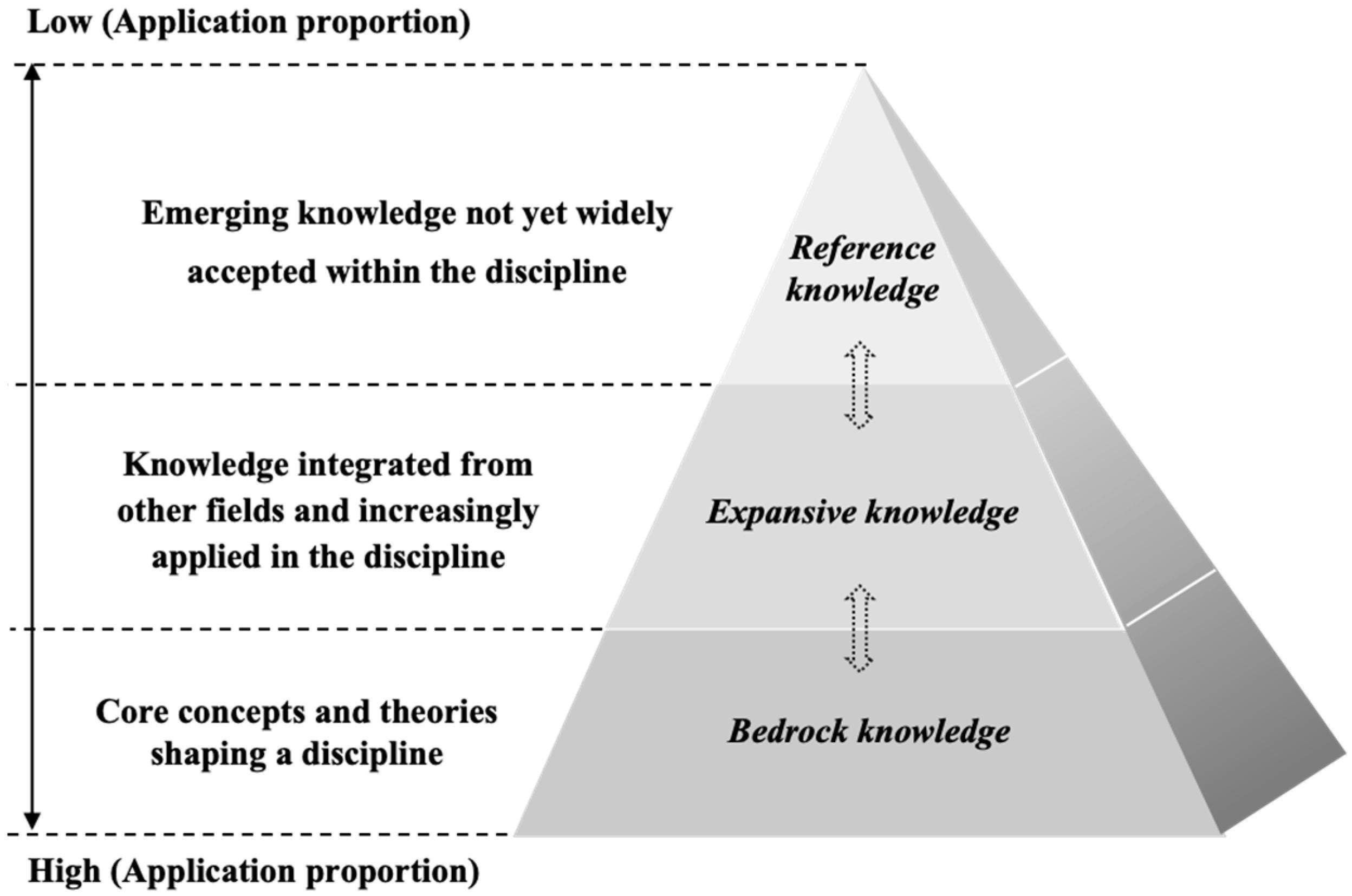
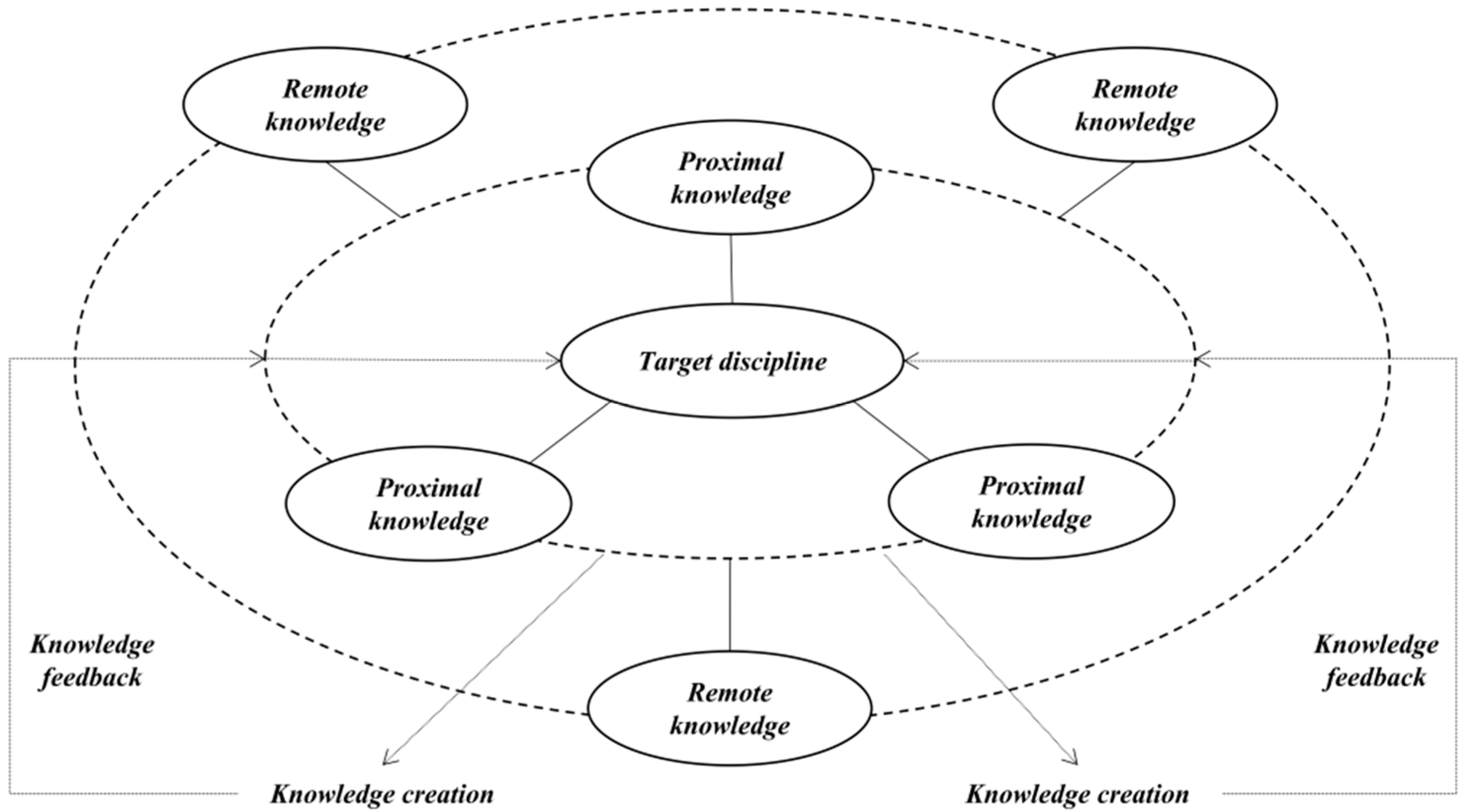
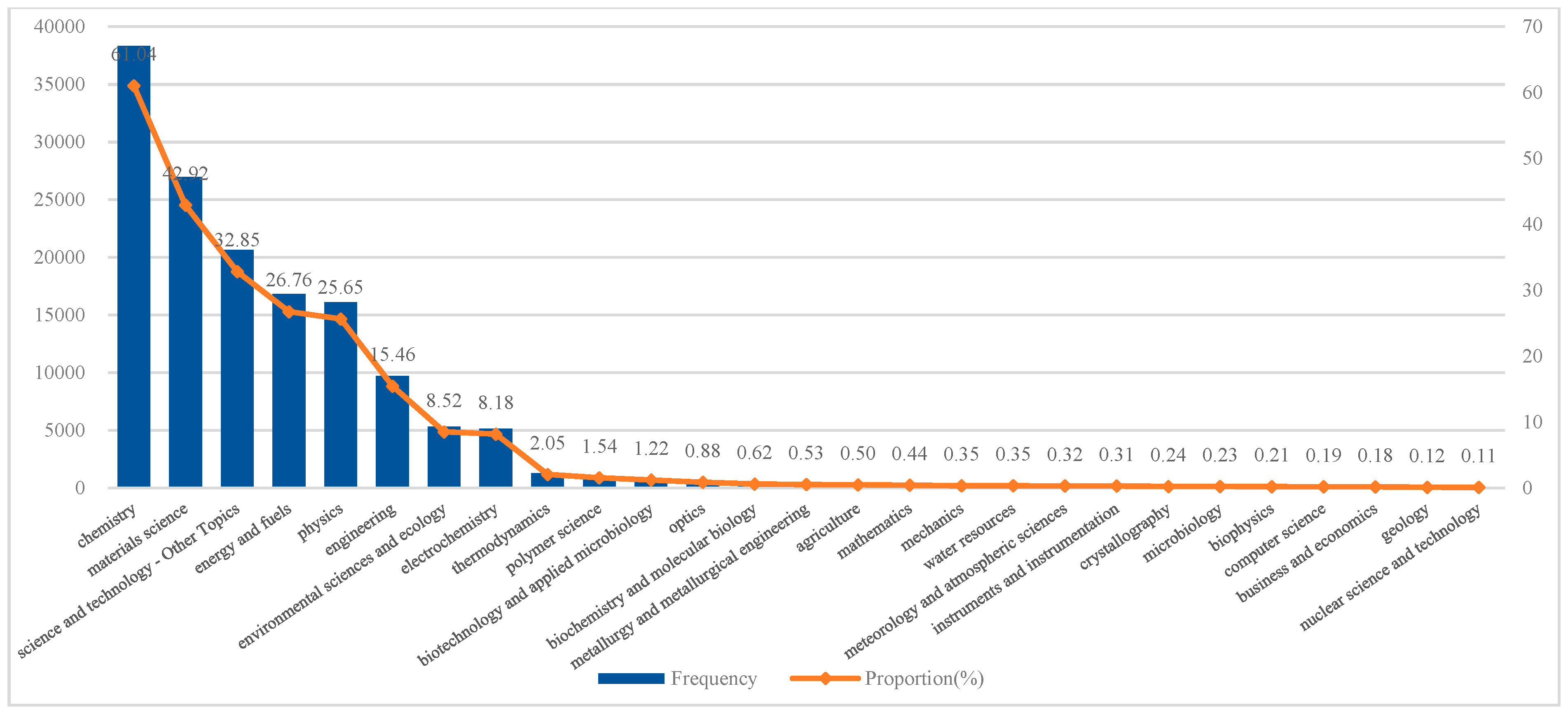

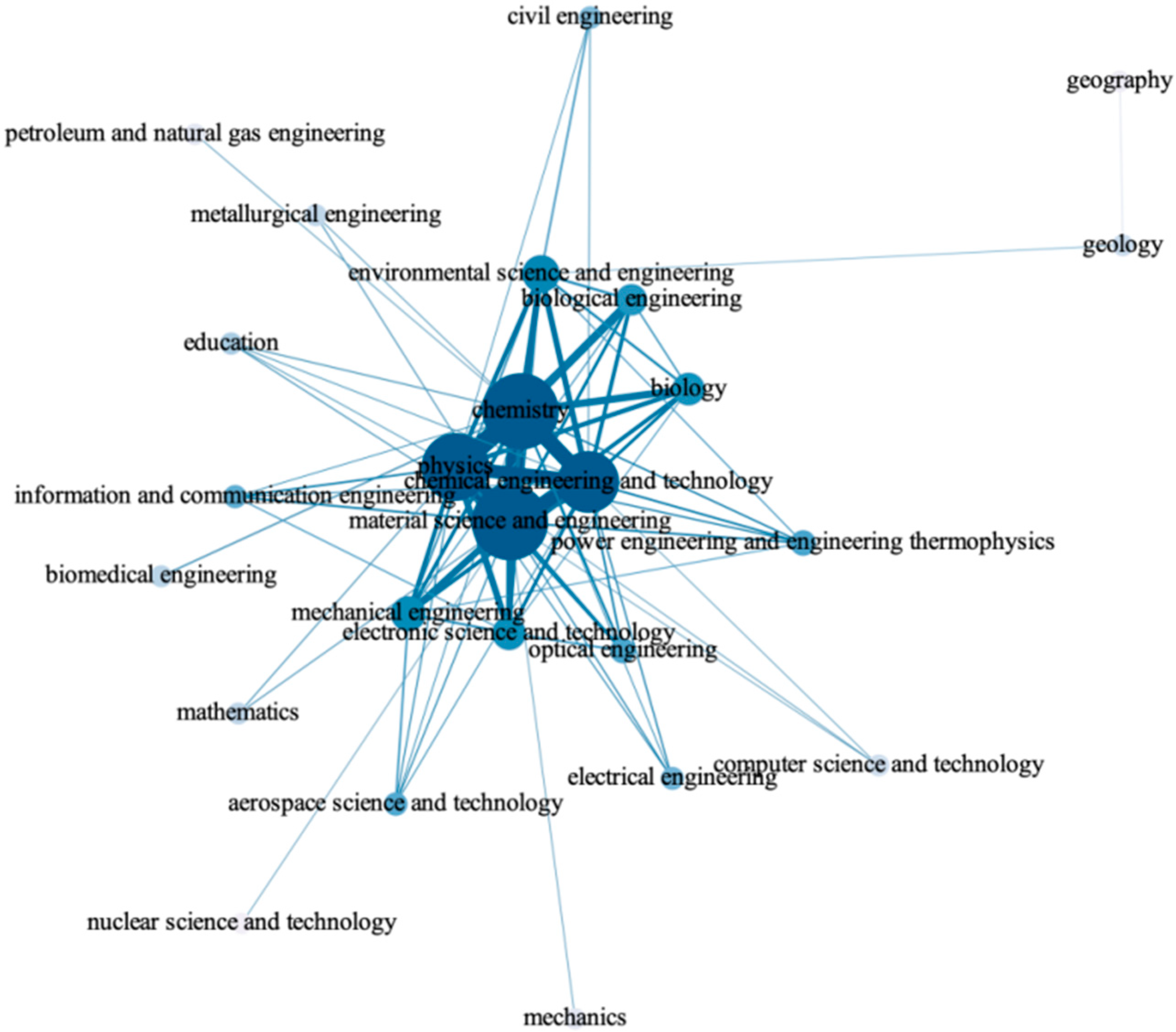
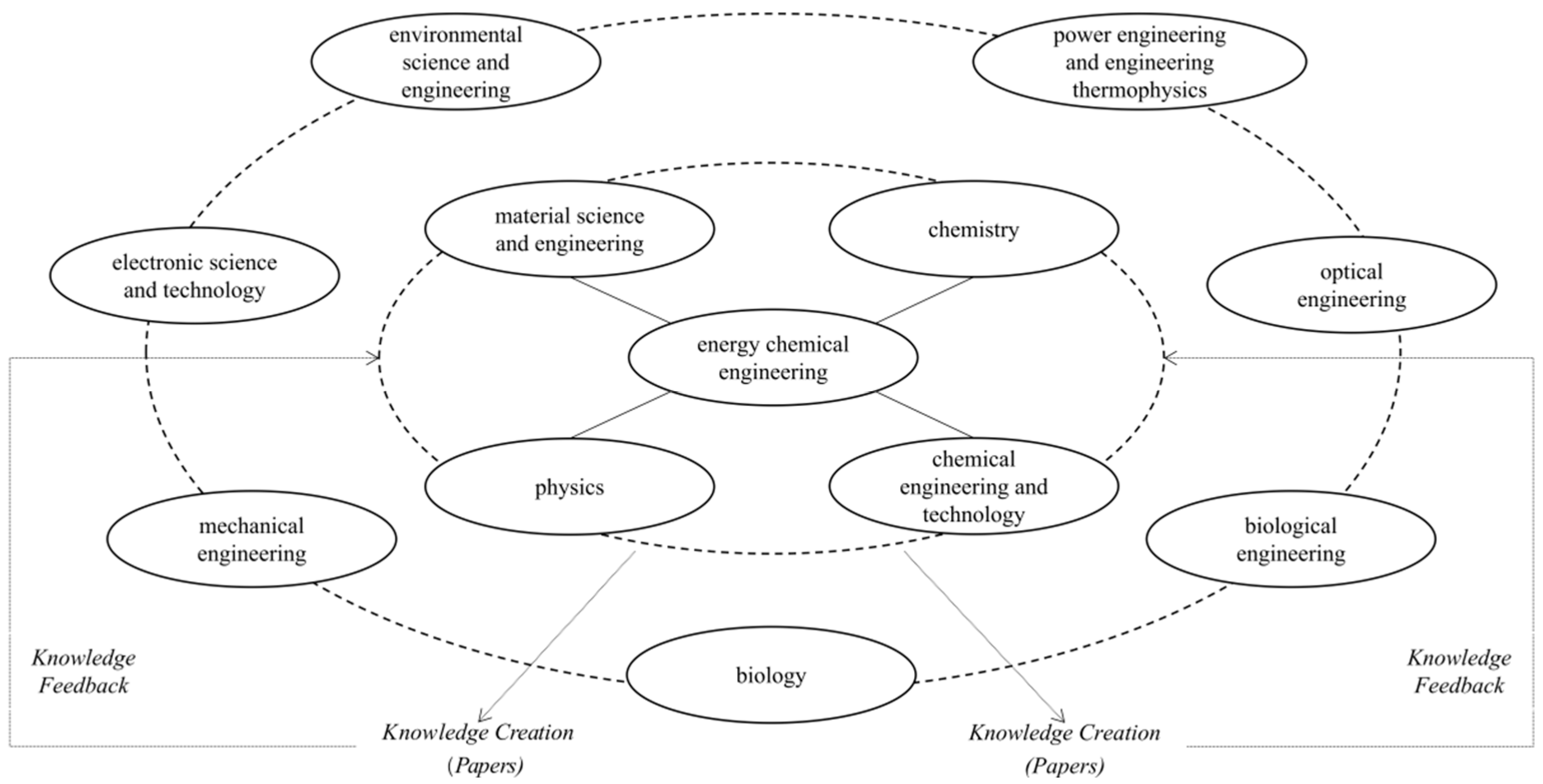
| Name | Category | 3-Year Average IF |
|---|---|---|
| Energy and Environmental Science | Q1 | 31.202 |
| Progress in Energy and Combustion Science | Q1 | 26.882 |
| Applied Catalysis B-Environmental | Q1 | 14.204 |
| Disciplines | Degree | NrmDegree | Disciplines | Degree | NrmDegree |
|---|---|---|---|---|---|
| material science and engineering | 1520 | 9.325 | biological engineering | 393 | 2.411 |
| chemistry | 1501 | 9.209 | optical engineering | 219 | 1.344 |
| physics | 1415 | 8.681 | power engineering and engineering thermophysics | 186 | 1.141 |
| chemical engineering and technology | 1208 | 7.411 | information and communication engineering | 130 | 0.798 |
| environmental science and engineering | 575 | 3.528 | electrical engineering | 111 | 0.681 |
| electronic science and technology | 471 | 2.89 | aerospace science and technology | 110 | 0.675 |
| mechanical engineering | 448 | 2.748 | civil engineering | 96 | 0.589 |
| biology | 411 | 2.521 |
Disclaimer/Publisher’s Note: The statements, opinions and data contained in all publications are solely those of the individual author(s) and contributor(s) and not of MDPI and/or the editor(s). MDPI and/or the editor(s) disclaim responsibility for any injury to people or property resulting from any ideas, methods, instructions or products referred to in the content. |
© 2024 by the authors. Licensee MDPI, Basel, Switzerland. This article is an open access article distributed under the terms and conditions of the Creative Commons Attribution (CC BY) license (https://creativecommons.org/licenses/by/4.0/).
Share and Cite
Zhang, H.; Chang, L.; Yang, Z.; Lu, J. Research on the Structure of Disciplinary Knowledge Systems from the Perspective of a Knowledge Behavior Strategy. Systems 2024, 12, 579. https://doi.org/10.3390/systems12120579
Zhang H, Chang L, Yang Z, Lu J. Research on the Structure of Disciplinary Knowledge Systems from the Perspective of a Knowledge Behavior Strategy. Systems. 2024; 12(12):579. https://doi.org/10.3390/systems12120579
Chicago/Turabian StyleZhang, Huiying, Le Chang, Zuguo Yang, and Juan Lu. 2024. "Research on the Structure of Disciplinary Knowledge Systems from the Perspective of a Knowledge Behavior Strategy" Systems 12, no. 12: 579. https://doi.org/10.3390/systems12120579
APA StyleZhang, H., Chang, L., Yang, Z., & Lu, J. (2024). Research on the Structure of Disciplinary Knowledge Systems from the Perspective of a Knowledge Behavior Strategy. Systems, 12(12), 579. https://doi.org/10.3390/systems12120579






